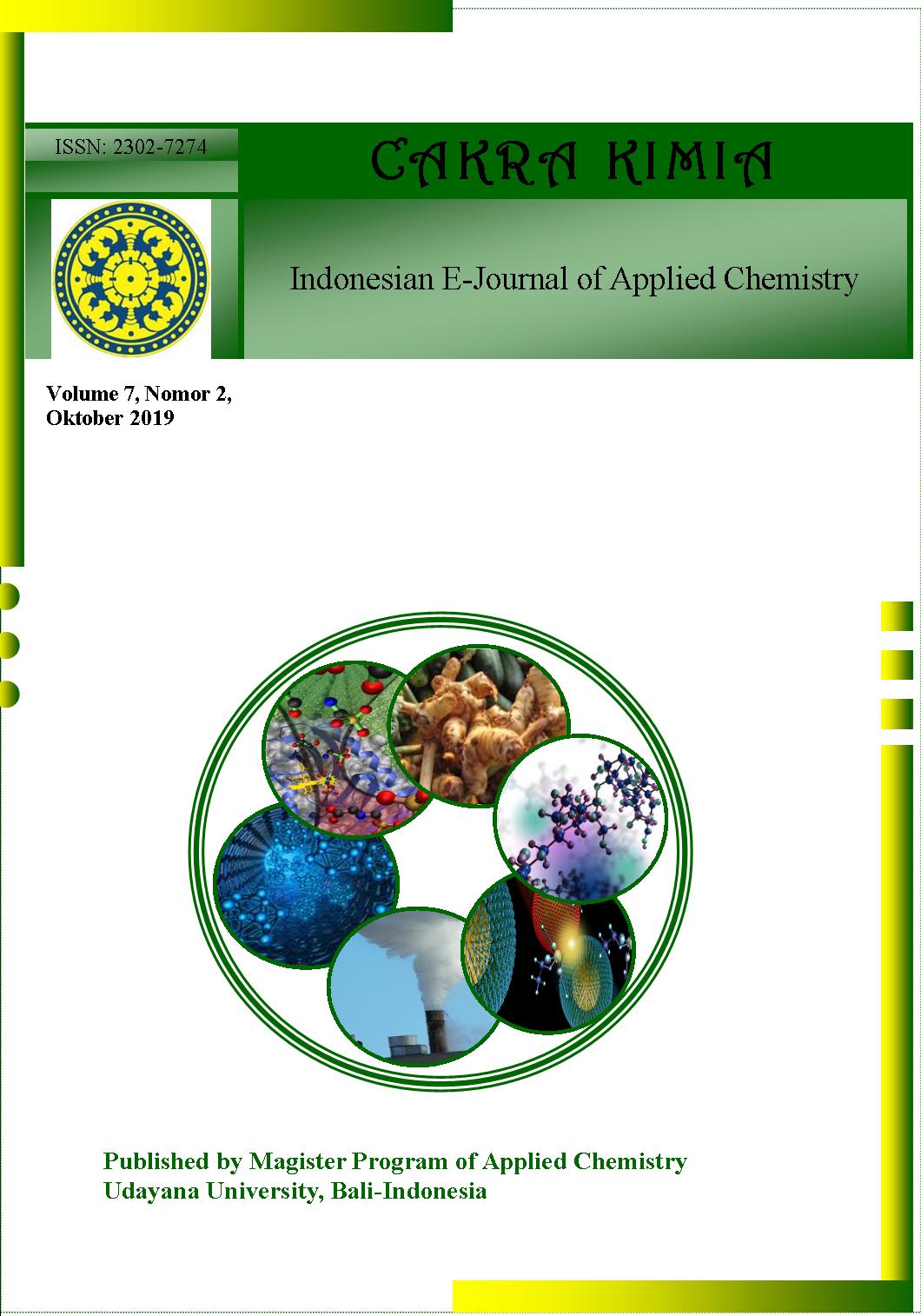SELULASE DAN AMILASE DARI DAUN LONTAR (Borassus flabelliformis) YANG TELAH LAPUK SERTA UJI INHIBISI DENGAN MINYAK SEREH DAN CENGKEH
Abstract
ABSTRAK: Pelapukan naskah lontar salah satunya disebabkan oleh mikroba yang menghasilkan enzim pendegradasi selulosa dan amilum yang terkandung dalam daun siwalan (lontar). Tujuan penelitian ini adalah untuk menentukan aktivitas selulase dan amilase dari mikroba selulolitik dan amilolitik yang diisolasi dari lontar yang telah lapuk, serta mengetahui kemampuan minyak sereh dan cengkeh menginhibisi aktivitas selulase dan amilase dari kedua jenis mikroba tersebut. Isolasi mikroba selulolitik dan amilolitik dari lontar yang telah lapuk dilakukan dengan metode pengenceran dan dikultivasi dalam media yang mengandung substrat spesifik. Substrat carboxymethyl cellulose (CMC) digunakan untuk mikroba selulolitik, sedangkan substrat amilum untuk mikroba amilolitik. Mikroba selulolitik dideteksi dengan adanya zona bening di sekitar koloni mikroba setelah ditambahkan larutan congo red 0,1% (b/v), sedangkan untuk mikroba amilolitik ditambahkan dengan larutan iodin 0,1% (b/v). Aktivitas selulase dan amilase ditentukan berdasarkan gula pereduksi yang dihasilkan dari reaksi enzim-substrat setelah direaksikan reagen dinitro salisilat (DNS) dan ditentukan dengan spektrofotometri UV-Vis. Hasil penelitian diperoleh mikroba selulolitik (C3B) dengan aktivitas selulase sebesar 0,068 U/mL; dan mikroba amilolitik (A5A) dengan aktivitas amilase sebesar 0,827 U/mL. Uji inhibisi menggunakan minyak sereh menunjukkan penurunan aktivitas selulase 4,41% dan penurunan aktivitas amilase 30,96%. Uji inhibisi menggunakan minyak cengkeh menunjukkan penurunan aktivitas amilase 92,50%. Hasil ini mengindikasikan adanya potensi minyak sereh dan cengkeh sebagai bahan untuk konservasi lontar.
Kata kunci: inhibitor; aktivitas enzim; selulase; dan amilase
ABSTRACT: Weathering of the manuscript was caused by one of the microbes that produced cellulose and starch degrading enzymes contained in the palm-leaf (lontar). The purpose of this study was to determine the activity of cellulase and amylase from cellulolytic and amylolytic microbes isolated from weathered palm, also know the ability of lemongrass and clove oil to inhibit cellulase and amylase activity from both types of microbes. Isolation of cellulolytic and amylolytic microbes from decaying palms was carried out by a dilution method and cultivated in media containing specific substrates. Carboxymethyl cellulose (CMC) substrate is used for cellulolytic microbes, while starch substrates for amylolytic microbes. Cellulolytic microbes were detected by the presence of clear zones around the microbial colonies after adding 0.1% (w/v) congo red solution, while for amylolytic microbes added with 0.1% (w/v) iodine solution. Cellulase and amylase activity was determined based on reducing sugars produced from enzyme-substrate reactions after reacting dinitro salicylate (DNS) reagents and determined by UV-Vis spectrophotometry. The results obtained by cellulolytic microbes (C3B) with cellulase activity of 0.068 U/mL; and amylolytic microbes (A5A) with amylase activity of 0.827 U / mL. Inhibition test using lemongrass oil showed a decrease in cellulase activity 4.41% and decreased amylase activity 30.96%. Inhibition testing using clove oil showed a 92.50% decrease in amylase activity. These results indicate the potential for lemongrass and clove oil as ingredients for palm-leaf conservation.
Downloads
References
[2] Burford, M.A., Thompson, P.J., McIntosh, R.P., Bauman, R.H., dan Pearson, D.C. 2004. Nutrien and Microbial Dynamics in High-Intensity. Zero Exchange Shrimp Ponds of Belize. Aquaculture. 219, 393-411.
[3] Brugnera, D.F. 2011. Ricotta: Microbiological quality and use of spices in the control of Staphylococcus aureus. Dissertation. University of Lavras, Lavras. Brazil.
[4] Alma, M.H., Ertas M., Nitz S., Kollmannsberger H. 2007. Chemical composition and content of essential oil from the bud of cultivated Turkish clove. BioResources. 2(2) : 265-269.
[5] Bailey, MJ. 1988. A note on the use to dinitrosalicyclic acid for determining the products of enzymatic reaction. App. Microbiol. Biotechnol. 29: 494 – 496.
[6] Wirajana, I.N., Kimura, T., Sakka, K., Wasito, E.B., Kusuma, E.K., & Puspaningsih, N.N.T. 2016. Secretion of Geobacillus thermoleovorans IT-08 α-L Arabinofuranosidase (AbfA) in Saccharomyces cerevisiae by Fusion with HM-1 Signal Peptide. Procedia Chemistry 18: 69 – 74.
[7] Sakti, P.C., 2012, Optimasi Produksi Enzim Selulase dari Bacillus sp. BPPT CC RK 2 dengan Variasi pH dan Suhu menggunakan Response Surfance Methodology, Skripsi, Depok, Fakultas Teknik Universitas Indonesia.
[8] Oktavia AD, Indiawati N, Destiarti L., 2013, Studi Awal Pemisahan Amilosa dan Amilopektin Pati Ubi Jalar (Ipomea batatas Lam) dengan Variasi Konsentrasi n-Butanol. JKK. 2 (3): 153-156.
[9] Jumepaeng, T., Prachakool, Luthria, D. L. dan Chanthai, S. 2013. Determination of Antioxidant Capacity and α-Amylase Inhibitory Activity Of The Essential Oils from Citronella Grass and Lemongrass. International Food Research Journal 20(1): 481-485.
[10] Aoudou Y., Leopold T.N., Michel J.D.P., Xavier E.F., Moses M.C. 2010. Antifungal properties of essential oils and some constituents to reduce foodborne pathogen. Journal Yeast and Fungal Research. 1: 1–8.
[11] Tolouee M, Alinezhad S, Saberi R, Eslamifar A, Zad SJ, Jaimand K, Taeb J, Rezaee MB, Kawachi M, Shams-Ghahfarokhi M, Razzaghi-Abyaneh M. 2010. Effect of Matricaria chamomilla L. flower essential oil on the growth and ultrastructure of Aspergillus niger van Tieghem. Int J Food Microbiol. 139:127–133.
[12] Marei, G.I.K., dan Abdelgaleil, S.A.M. 2018. Antifungal Potential and Biochemical Effects of Monoterpenes and Phenylpropenes on Plant Pathogenic Fungi. Plant Protect. Sci. 54 (1): 9–16.
[13] Vanin, A.B., Orlando T. Piazza, S.P., Puton, B.M.S., Cansian, R.L., Oliveira, D., dan Paroul N. 2014. Antimicrobial and Antioxidant Activities of Clove Essential Oil and Eugenyl Acetate Produced by Enzymatic Esterification, Appl Biochem Biotechnol. 12 (1): 0-14.
[14] Santos, A.O., T. Ueda-Nakamura, B. P. Dias Filho, V. F. Viega, A. C. Pinto, and C. Nakamura. 2008. Effect of Brazilian copaiba oils on Leishmania amazonensis. Journal of Ethnopharmacology. 120: 204–20.



 Petunjuk Penulisan
Petunjuk Penulisan
